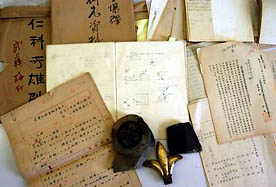
- Materials donated to Peace Memorial Museum
Survey notes, a special committee internal notice ordering a halt to publication of a research paper, and other materials have been found in the Musashino City, Tokyo home of Yoshio Suge, professor emeritus of Tokyo University. Professor Suge, who died in 1985, was a member of the Special Committee to Study A-bomb Damage set up by the (then) Ministry of Education to study Hiroshima and Nagasaki in the aftermath of the atomic bombings. A representative of the Peace Memorial Museum (Naka-ku, Hiroshima City) to which the family donated the materials, said, "These materials are valuable for what they reveal about the survey process."
Roughly 30 items were found, including notes, internal documents, A-bomb artifacts, and photos taken for the survey.
During an academic conference on September 14, 1945, the Ministry of Education launched the special committee to comprehensively study the damage caused by the atomic bombings. The leading Japanese scholars who attended were divided into nine subcommittees that included the areas of medicine, physics, and geoscience. As secretary of the Machine and Metallurgy Society, Professor Suge headed a group that studied the temperature and blast pressure of the A-bomb.
Suge's survey notes begin on October 5, 1945 with a report on the survey underway by Hiroshima University of Literature and Science. They include sketches of stone pillars on the Motoyasu Bridge and Stone lanterns at Hiroshima Gokoku Shrine that were dislodged by the blast. They meticulously record the process of detecting the location of the hypocenter. On October 8th, Suge went to Nagasaki to study the situation for three days and returned to Hiroshima on the 14th. He visited the sites of Shima Hospital (the hypocenter), Shirakami Shrine, the Hiroshima Branch of the Bank of Japan, and other places.
The artifacts include A-bombed roof-tiles and other items collected near Shima Hospital and the Urakami Cathedral area in Nagasaki.
The internal documents include a notice on December 11, 1945, ordering suspension of publication of a research paper and a notice of approval of publication two years later. Another important government document explains the restrictions on A-bomb research ordered by Allied General Headquarters (GHQ).
Suge's eldest son Kenichi (70), (Musashino City) found the materials packed in a cardboard box in May this year when he was going through his father's room. Kenichi said, "My father told me many times about his experiments melting the surfaces of roof tiles. I hope the materials will be useful."
Yasutaka Hamamoto, Supervisor of the Peace Memorial Museum said, "The discovery of an organized collection of materials describing the conditions under which surveys were conducted under the occupation is highly significant." The museum is considering adding an exhibition of these materials to the current "It was an atomic bomb" Exhibition.
(Caption)Survey notes, A-bombed roof tiles, and other materials from post-bombing Hiroshima left by Suge
    
|